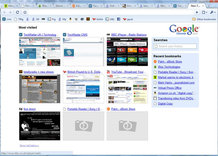Tomorrow's trends in web design revealed
What's in store for web designers and developers this year

In many ways, 2008 was a year of continuation and gentle evolution.
Despite the maturity of concepts such as mashups and social networking – to the point where both are now considered de rigueur – and the increasing use of frameworks, libraries and JavaScript, the year often found the industry treading water. Concentration was on refinement rather than revolution.
The current challenging economic conditions have those in the industry divided regarding what's in store.
Some, increasingly aware of diminished budgets (and with them, expectations), consider 2009 a time to tighten belts, knuckle down and work with clients on patiently polishing existing content.
Most, though, suggest now is the time to throw caution to the wind, embrace new technologies, get your name out there and differentiate yourself from the competition.
A wider remit
The second argument holds water when you consider the number of platforms ripe for exploitation and development.
Get daily insight, inspiration and deals in your inbox
Sign up for breaking news, reviews, opinion, top tech deals, and more.
We're finally enjoying a period where multi-platform browsing is viable – even on games consoles, which turn televisions into web-browsing tools – and this will provide opportunities in 2009 for designers and developers savvy enough to take advantage.
In 2008, the iPhone confounded expectations. Many thought Apple's gadget would be the device that sank the Cupertino giant; instead, it's a success – largely because of its online capabilities. The built-in browser lacks Flash support but nonetheless provides an experience akin to desktop web-browsing, while a host of applications for accessing web services such as eBay and Facebook pepper the iTunes App Store.
"The popularity of the iPhone and subsequent rise of touchscreen mobile devices will see increased demand, and need, for 'iPhone versions' of sites in 2009, customised to its viewport and circumventing its lack of Flash," believes Kleber's Tom Muller. Although the iPhone is currently the main protagonist, Muller believes demand will rapidly expand to include other portable devices.
As Delete's digital art director Tom Dougherty notes, there's a beauty to mobile platforms, in that there's no variance. "Test on one device and you're done – that alone makes the iPhone compelling to develop for," he says. "Add to this the fact that Safari for iPhone is almost identical to the desktop version. This means making iPhone-specific layouts is often just a matter of tweaking style sheets."
Paul Annett, design lead at Clearleft, has also noticed mobile's increasing importance and describes a general trend towards online services with multiple ways of accessing and editing data, without the necessity to use websites. These include sending Twitters from a mobile, which update his Facebook status, and uploading gig photos to Flickr, which his friends can discover via Last.fm's event page.
"Real-world socialisation has become easier and richer through online services, but I never have to go to a website to use them," he says. "This trend of web ubiquity will continue as developers find ever-more ingenious ways to enrich our lives for our convenience."
2Advanced's Eric Jordan also puts the smart money on a move away from the browser in 2009. "Developers are beginning to see it as a limited, cumbersome method of retrieving information – the internet is more frequently used for functions beyond simply browsing websites and so the browser, as it stands, is called into question."










